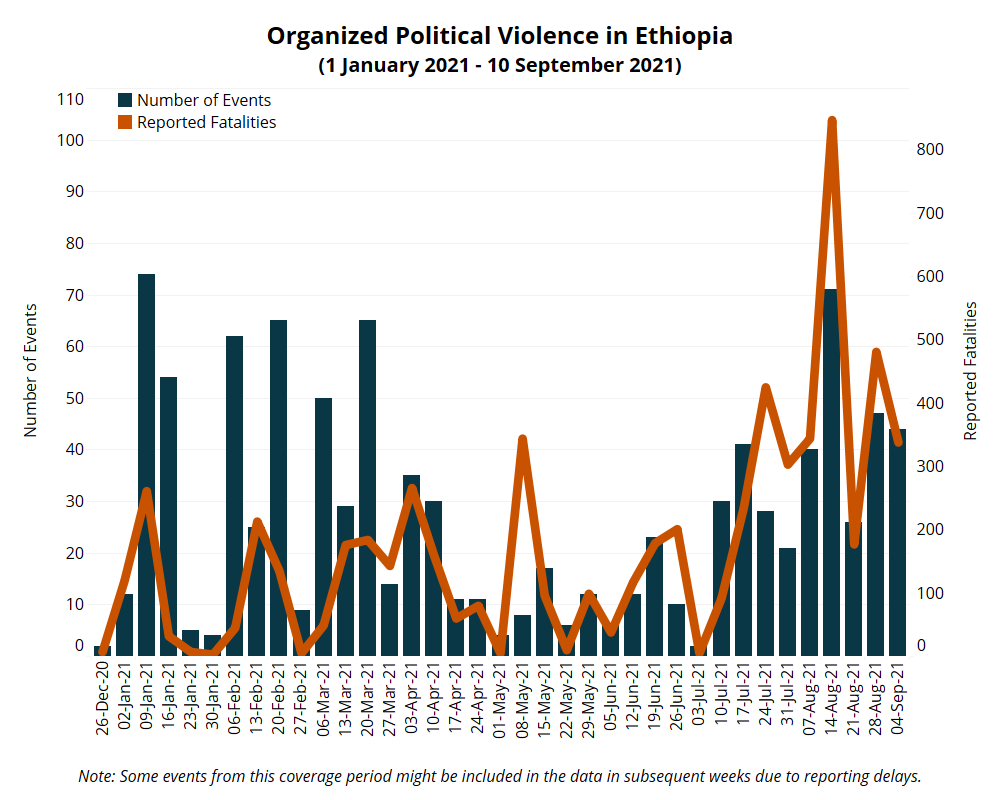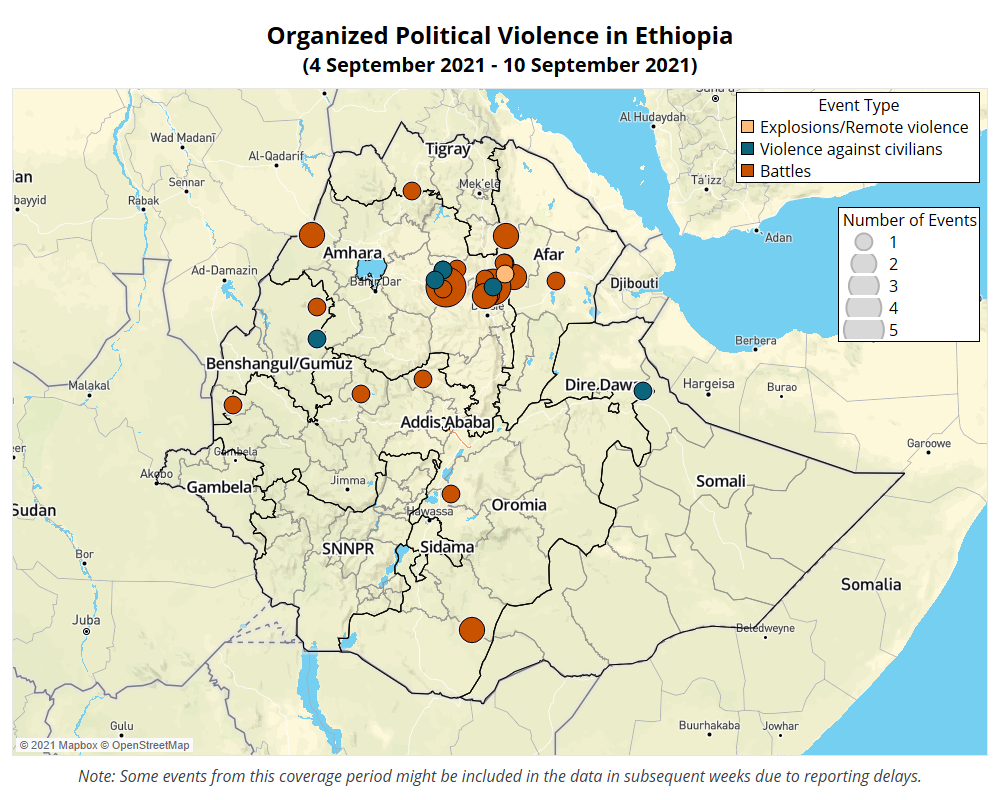By the Numbers: Ethiopia, 2 April 2018-10 September 20211Figures reflect violent events reported since Prime Minister Abiy Ahmed came to power on 2 April 2018.
- Total number of organized violence events: 1,987
- Total number of reported fatalities from organized violence: 11,792
- Total number of reported fatalities from civilian targeting: 5,434
By the Numbers: Ethiopia, 4-10 September 20212Some events from this coverage period might be included in the data in subsequent weeks due to reporting delays.
- Total number of organized violence events: 44
- Total number of reported fatalities from organized violence: 338
- Total number of reported fatalities from civilian targeting: 5
Ethiopia data are available through a curated EPO data file as well as the main ACLED export tool.

Situation Summary
Last week, the Oromo Liberation Front (OLF)-Shane clashed with the Ethiopian National Defense Force (ENDF) in Guji, Horo Guduru, West Wollega, Arsi, and North Shewa zones. Similarly, the Tigray People’s Liberation Front (TPLF) forces continued to clash with ENDF and different regional forces in Tigray, Amhara, and Afar regions (see map below).

In Oromia region, on 4 September 2021, OLF-Shane and ENDF clashed in Gumi Eldalo woreda in Guji zone and Shambu woreda in Horo Guduru Wollega zone (OMN, 11 September 2021). The following day the two sides clashed in Begi town in West Wollega zone (OMN, 11 September 2021). On the same day, the two groups also clashed in Kuyu woreda in North Shewa zone. On 7 September 2021, OLF-Shane militias attacked five convoys of the ENDF in Irresa Liban area in Gumi Eldalo woreda (OMN, 11 September 2021). Two days later, the two groups clashed in Munessa woreda in Arsi zone. The number of fatalities due to these clashes has not been independently verified. Since OLF-Shane announced its alliance with TPLF in August 2021, the frequency of clashes has increased in Oromia region.
Meanwhile, last week, the Ethiopian government stated that Afar region is currently under the control of ENDF and Afar forces. At the same time, TPLF claimed that its forces voluntarily withdrew from Afar region and were redeployed to Amhara region (Reuters, 9 September 2021). On 6 September 2021, ENDF clashed with TPLF in Uwa and Hida woredas in Afar region, taking control of Uwa shortly after. ENDF forces attacked TPLF forces using airstrikes in Awra and Hida woredas in Afar region. The next day, ENDF forces clashed with TPLF forces in Gulina, Yallo, Awra, and Kelwan woredas in Afar region, taking control of these woredas shortly after.
In Amhara region, armed clashes were recorded between TPLF and Amhara regional special force and Amhara militia in Filakit Geregera in North Wello zone from 4 to 8 September. On 4 September 2021, the Republican Guard, which is a branch of ENDF, clashed with TPLF forces in Chobe, Kelelti, Serti, and Kela mountains in Dire Roka. Normally, the Republican Guard is assigned to protect higher officials from any threats and attacks. However, since August 2021, different security sectors of the government have become actively involved in the conflict. Last week, armed clashes between TPLF and ENDF, allied with different regional forces, were recorded in North Wello, South Wello and West Gondar zones.
Clashes in North Gondar and South Gondar zones in Amhara region where the two groups have previously clashed over the last month have subsided. At the beginning of September, the government regained control of some of these areas, allowing reports on the damage caused by the conflict to surface. Last week, it was reported that on 1 and 2 September 2021, TPLF forces attacked the town of Chenna, located five kilometers from Dabat in North Gondar zone, killing at least 120 civilians (Reuters, 9 September 2021). TPLF denied this accusation and asked for an independent investigation (Getachew K. Reda, 8 September 2021).
Furthermore, on 6 September 2021, TPLF forces and Qemant militia continued to clash with ENDF, Amhara regional forces, and Amhara militia in Tiha (ESAT, 9 September 2021). The next day, they clashed in Shinfa and Gubay, resulting in an unconfirmed number of fatalities. The groups first clashed in Shinfa on 1 September 2021. According to the government, TPLF forces mobilized from Sudan in order to enter Ethiopia.
In the North-Western Tigray zone, clashes between TPLF and the Amhara regional special forces, Amhara militia, and Fano militias continued in Weken area in May Tsemre.
In Benshangul/Gumuz region, attacks by a Gumuz armed group continued. Last week, on 8 September 2021, a Gumuz armed group reportedly shot and killed five security officers (four members of the federal police and one member of ENDF) and two civilians, including a Chinese citizen, in Dangur woreda in Metekel zone. Two more security officers were also injured. The ENDF and regional special forces subsequently attacked the group, killing an unknown number of Gumuz militants. Since July, violence has increased in Benshangul/Gumuz region. For more details on conflict in the region, see the EPO Monthly: August 2021 report.
Weekly Focus: Humanitarian Crises in the North
Ethiopia celebrated its new year last week. Normally, a new year brings hope for the future. However, many are worried about the escalating humanitarian crises due to the ongoing conflict in the north. Until June 2021, the conflict between the federal government and TPLF was contained in Tigray region. After the ENDF withdrew from the Tigray region, the conflict area expanded to the neighboring Afar and Amhara regions. There are also claims that TPLF forces are fighting government forces alongside OLF-Shane and Gumuz armed groups in Oromia and Benshangul/Gumuz regions, respectively.
Humanitarian assistance is not fully reaching the Tigray region. According to the United Nations Office for the Coordination of Humanitarian Affairs (UNOCHA), since 12 July 2021, “less than 10 percent of the required humanitarian cargo” reached the region (OCHA, 2 September 2021). One of the reasons provided by the government when announcing a unilateral ceasefire and withdrawing from Tigray region was farmers’ need to utilize the rainy season for farming. However, it is unknown whether farmers were able to farm during this rainy season. According to UNOCHA, only 320,000 hectares of farmland out of 1.3 million hectares were cultivated (OCHA, 2 September 2021). It is estimated that 5.2 million people need humanitarian assistance in the Tigray region (OCHA, 2 September 2021). Thus, last week, the Ethiopian Human Rights Commission released a statement asking the federal government to expedite its efforts to deliver humanitarian assistance to the region (Ethiopian Human Rights Commission, 11 September 2021). The government continues to blame TPLF forces for hindering humanitarian assistance from reaching the Tigray region (EBC, 6 September 2021).
Furthermore, as the conflict area has expanded to Amhara and Afar regions, the number of people in need of humanitarian assistance has also increased. Different reports which were released last week indicate that farmers in Amhara region were not able to properly cultivate their land due to clashes between TPLF and the government forces. Moreover, TPLF forces reportedly killed the farmers’ cattle in some areas of Amhara region. According to the government, around 400,000 people are internally displaced from Afar and Amhara regions because of the conflict. Another four million people are on the verge of needing humanitarian assistance in both regions (EBC, 6 September 2021). UNOCHA has stated that 1.7 million people are food insecure due to the conflict in both regions (OCHA, 2 September 2021). Last week, the North Gondar zone administration stated that the North Gondar zone is hosting 40,000 internally displaced people (IDP) from the conflict affected areas in Amhara region (Amhara Media Corporation, 6 September 2021). Similarly, the South Wello zone is hosting 233,400 IDP from Wag Hamera, North Wello zones in Amhara region, and from Afar region (ESAT, 6 September 2021).
As the conflict between TPLF and government forces continues, the number of affected civilians in need of humanitarian assistance will continue to escalate. It is expected that in this new Ethiopian year, many will still need humanitarian assistance until they can return to their homes and cultivate their land.






